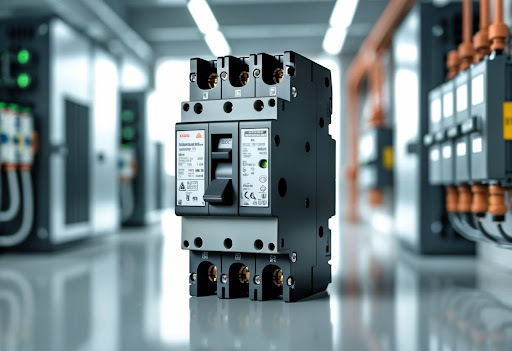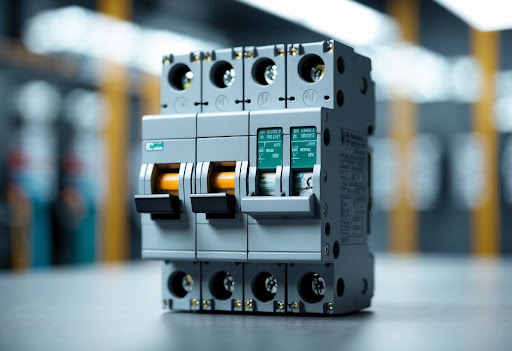.png)
MCB
Molded Case Circuit Breakers, or MCCBs, play a vital role in modern electrical systems. They function as protective devices that guard circuits from overloads, short circuits, and current surges. MCCBs are essential for ensuring the safety and reliability of electrical systems in both industrial and commercial settings.

These devices automatically disconnect power in the event of faults, preventing potential damage to equipment and reducing fire risks. With adjustable trip settings, MCCBs can be tailored for different applications, making them versatile for various electrical needs. Understanding how MCCBs operate and their features can help individuals make informed decisions when selecting the right protection for their circuits.
In this blog post, readers will explore the key aspects of MCCBs, including their construction, types, working principles, and applications. By gaining insight into these important devices, readers will be better equipped to manage electrical safety in their environments.

Molded Case Circuit Breakers (MCCBs) are vital in protecting electrical circuits from overloads and short circuits. They are different from miniature circuit breakers (MCBs) and have specific applications, especially in industrial settings.
A Molded Case Circuit Breaker (MCCB) is an automatic electrical device designed to protect circuits from faults. It operates by interrupting the flow of electricity during conditions like overloads and short circuits.
MCCBs have an enclosure made of molded plastic that houses their internal mechanisms. This construction helps to ensure safety and durability. MCCBs typically handle currents up to 2500 Amps and voltages up to 1.1 kV. Their adjustable trip settings make them versatile for various applications.
Key functions include:
While both MCCBs and miniature circuit breakers (MCBs) serve to protect electrical circuits, they have distinct differences.
|
Feature |
MCCB |
MCB |
|
Maximum Current |
Up to 2500 Amps |
Typically up to 100 Amps |
|
Trip Settings |
Adjustable |
Fixed |
|
Common Uses |
Industrial applications |
Residential use |
MCCBs are widely used in various industrial applications due to their ability to manage high electrical loads. They are essential for protecting:
MCCBs are essential for maintaining safety and efficiency in electrical systems where high current management is critical.
Molded case circuit breakers (MCCBs) have essential components that work together to provide protection in electrical systems. Understanding these components aids in appreciating how MCCBs function effectively.
The molded case is the protective outer shell of the MCCB. It is constructed from durable insulating materials, often thermoset plastic, which provides mechanical strength and electrical insulation. The design helps contain critical internal components and shields them from external environmental factors.
The frame defines the physical structure of the MCCB and is engineered to house the key elements. It is crucial for maintaining rated insulation voltage and ensuring the stability of the unit. Frames come in various sizes to accommodate different current ratings, thus enabling flexibility in installation and application.
Terminals play a vital role in connecting the MCCB to the electrical circuit. They are designed to facilitate secure and reliable electrical connections. Typically, these terminals are made from conductive metals to ensure minimal resistance.
The terminal connectors can vary in type, including screw type or spring-loaded options, providing different levels of connectability. Proper installation of the terminals is critical for effective current carrying and overall safety of the electrical system. Incorrect connections can lead to overheating or failure of the breaker.
Moving contacts are a key component within the MCCB that open and close to interrupt the flow of current. These contacts are engineered to separate quickly during a fault condition, effectively stopping excess current from flowing.
Arc chutes are critical for managing the energy produced when the contacts open. They help extinguish the arc that forms as the contacts separate, thus preventing damage to the breaker. Equipped with special materials, arc chutes enhance the interruption capacity of the MCCB, allowing it to handle significant fault currents safely. This combination of moving contacts and arc chutes ensures reliable performance during overload and short circuit conditions.
Molded Case Circuit Breakers (MCCBs) rely on several key mechanisms to ensure electrical safety. These include different types of trip units, thermal protection using bimetallic strips, and magnetic protection via solenoids. Each component works together to protect circuits from overloads and short circuits.
The trip unit is a critical component of an MCCB. It senses abnormal conditions in the circuit and triggers the operating mechanism to open the contacts. There are generally three types of trip units: thermal, magnetic, and electronic.
Thermal protection in MCCBs is commonly provided by a bimetallic strip. This strip consists of two different metals bonded together. When current flows through the strip, it heats up due to electrical resistance. As it heats, it bends.
If the current exceeds a predefined limit for an extended period, the bending action of the strip trips the circuit breaker. This mechanism is crucial for protecting against sustained overloads, ensuring that equipment operates safely.
Magnetic protection in MCCBs is primarily achieved through a solenoid mechanism. When a fault occurs, such as a short circuit, the current sharply increases. This increase generates a magnetic field strong enough to activate the solenoid.
The solenoid rapidly pulls a lever that trips the breaker almost instantly. This rapid response is essential for protecting circuits from immediate damage, preventing potential hazards and equipment failures.
MCCBs feature both manual and automatic operating mechanisms. The manual mechanism allows an operator to reset the breaker after it has tripped. This can be done by moving the handle back to the "on" position.
The automatic mechanism works without human intervention. Once the trip unit detects a fault condition, it engages the operating mechanism to open the contacts and interrupt the current flow. This dual functionality enhances user safety by ensuring immediate response during fault conditions while still allowing for manual operation if needed.
Molded Case Circuit Breakers (MCCBs) come with specific ratings and features that determine their performance in protecting electrical circuits. Understanding these ratings, including current ratings, breaking capacity, and adjustable trip settings, is essential for effective application.
The current rating of an MCCB indicates the maximum continuous current it can handle without tripping. It is expressed in amperes (A) and helps select the right breaker for the application. Common current ratings for MCCBs range from 15A to 3,200A.
To ensure proper protection, users must match the MCCB rating to the load current of the circuit. An incorrectly rated MCCB can lead to under or overprotection, causing potential safety hazards or equipment damage.
Breaking capacity refers to the maximum fault current that an MCCB can safely interrupt. This is crucial for protecting electrical systems during faults.
MCCBs have two key breaking capacities:
Choosing the right breaking or interrupting capacity is essential for ensuring that the circuit protection remains effective during fault conditions.
MCCBs are designed with adjustable trip settings, which allow users to control how these devices respond to overloads and short circuits. These settings can be altered based on application needs.
Key features of adjustable trip settings include:
This flexibility enables proper coordination with other protective devices in the system to enhance safety and effectiveness. Proper calibration is crucial for reliable operation.
Molded Case Circuit Breakers (MCCBs) are essential devices that provide critical protection features to ensure electrical safety. They help prevent damage to equipment and enhance user safety through overload protection, short circuit protection, and earth fault protection.
Overload protection is vital for preventing damage when electrical circuits carry more current than they can handle. MCCBs are designed to detect excessive current flow over time and automatically trip the circuit when the limit is exceeded.
This function protects wiring from overheating and potential fires. It uses thermal trip elements that respond to the heat generated by the current. Users can often adjust the settings to match the specific requirements of their electrical system.
Common features for this type of protection include:
Short circuits can cause significant damage by allowing a large amount of current to flow uncontrollably. MCCBs are equipped to respond quickly to such faults. When a short circuit occurs, the breaker interrupts the current flow almost instantly.
This immediate response prevents equipment damage and reduces safety risks for users. Most MCCBs utilize magnetic trip elements that react without delay, tripping the circuit immediately.
Key characteristics include:
Earth fault protection is crucial for ensuring user safety by detecting fault currents that may occur when electrical current escapes to the ground. MCCBs that feature this protection help to identify earth faults, which can lead to electric shock or fire hazards.
When a fault is detected, the MCCB quickly disconnects the supply to prevent further danger. This feature is particularly important in residential and commercial applications, where human safety is a top priority.
Important aspects of earth fault protection include:
MCCBs play a significant role in maintaining electrical safety within various systems. They protect against overloads, short circuits, and earth faults, ensuring a safer environment for both users and equipment.
To enhance safety further, regular maintenance and testing of MCCBs are essential. Users should ensure that their breakers are correctly rated for their specific applications. Additionally, understanding the functions and settings of the MCCB can help in preventing accidental trips and improving overall system reliability.
Essential safety tips include:
Regular testing and maintenance of Molded Case Circuit Breakers (MCCBs) are essential for ensuring their reliability and safety. Proper procedures can help identify potential issues before they lead to failures. The following sections outline methods for testing and maintenance, along with best practices for installation.
Routine testing should be conducted periodically to ensure that MCCBs function correctly. Visual inspections are the first step. They should check for physical damage and ensure that all connections are tight.
Common tests include:
Experts suggest that if an MCCB has not been operated for over six months, it should be manually exercised multiple times. This helps maintain contact cleanliness and verifies that moving parts are functioning.
The insulation resistance test is crucial for assessing the health of the MCCB. This test evaluates the integrity of the insulation that separates the conductive elements inside the breaker.
For performing the test:
Results should exceed industry standards, typically at least 1 megaohm for safe operation. Lower readings indicate potential insulation breakdown, which requires attention. Regular insulation testing helps in taking preventive actions before failures occur.
Proper installation is critical for the effective operation of MCCBs. Breakers should be mounted securely and aligned according to the manufacturer's specifications. Loose connections can lead to overheating and premature failure.
Routine maintenance should focus on:
Following these practices not only extends the lifespan of the MCCB but also enhances safety. Regular monitoring and upkeep contribute to the overall reliability of the electrical system.
Premium electrical and automation equipment plays a crucial role in ensuring the efficiency and safety of electrical systems. These devices include a variety of components like circuit breakers, sensors, and control systems.
One key product in this category is the Molded Case Circuit Breaker (MCCB). This device protects against overloads and short circuits, making it essential for both residential and industrial applications.
Benefits of Using High-Quality Equipment:
Manufacturers of premium electrical gear focus on advanced technologies to improve functionality. For example, devices may include features like thermal and magnetic trip mechanisms.
Additionally, automation solutions have become a vital part of modern electrical infrastructure. These solutions streamline operations, enhance productivity, and minimize human errors.
For sourcing such equipment, Gabby Electric offers a wide range of automation and electrical components. With competitive prices and fast delivery, it is a reliable choice for both businesses and individuals.
Purchasing quality equipment can lead to long-term cost savings and improved performance of electrical systems. Investing in premium products ensures that systems operate smoothly, serving their intended purpose effectively.
.jpg)
Qatar Secures Place Among the World's Top 10 Wealthiest Nations
.jpg)
Hamad International Airport Witnesses Record Increase in Passenger Traffic

Saudi Arabia: Any visa holder can now perform Umrah

What are Qatar's Labour Laws on Annual Leave?
Leave a comment